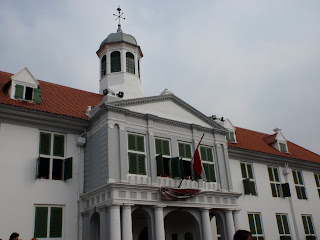We started our two-week trip to Indonesia in Jakarta. 'The Big Durian' is Jakarta's unofficial nickname, supposedly given to it by expats because it's spiky and smelly on first glance, but warm and delicious once you get to know it. (I can certainly confirm the smelly part of the description!).
Arriving late at night we started our visits the next day with Indonesia's National Museum, also known as the 'Elephant Museum' by the locals as it has a statue of an elephant outside (which you can just see to the right on this photo).
 |
| part of the museum's stone sculpture collection |
One of the museum's centrepieces is a 4-metre tall stone sculpture of Aditawarman, a 14th-century nobleman:
 |
| notice the ring of skulls on which he is standing |
Opposite the museum is a park called Merdeka Square, in the middle of which is the towering Monas, (aka National Monument), built by President Soekarno in the 1960s, and probably Jakarta's main landmark.
 |
| the 132-metre high Monas |
 |
| lunch! (chicken noodles) |
 |
| Jakarta Roman Catholic Cathedral |
 | ||
| some friendly security guards |
The statue below is the West Irian Liberation Monument, erected to celebrate the liberation of this province from Dutch imperialism. This region is now known as West Papua, and is the western half of the island of New Guinea. However, an independence (from Indonesia) movement is active.

The Gedung Pancasila building is famous as the place where Soekarno paved the way for Indonesia's constitution following a 1945 speech there.
 |
| frog? toad? |
On our second day we went to the old port area of Sunda Kelapa, which is full of pinisi, traditional two-masted wooden ships.
 |
| pinisi |
 | |||
| kids, Sunda Kelap |
 | |
| Sunda Kelapa |
A landmark of the area is the old watchtower, built by the Dutch, built in 1839.
There's not much to see inside, but you get a good view from the top, as you can see from the following photos.
 |
| Looking north from the watchtower |
After Sunda Kelapa we visited Kota, the old part of Jakarta (which was known as Batavia under Dutch rule), whose central square is Taman Fatahillah. Here's the old town hall, now a history museum:
After we left Jakarta we flew to Yogyakarta for the next step of our trip. After that we travelled to Pulau Weh (Northern Sumatra) for a week of scuba-diving.
Suggested reading :
Krakatoa: The Day the World Exploded: August 27, 1883





No comments:
Post a Comment